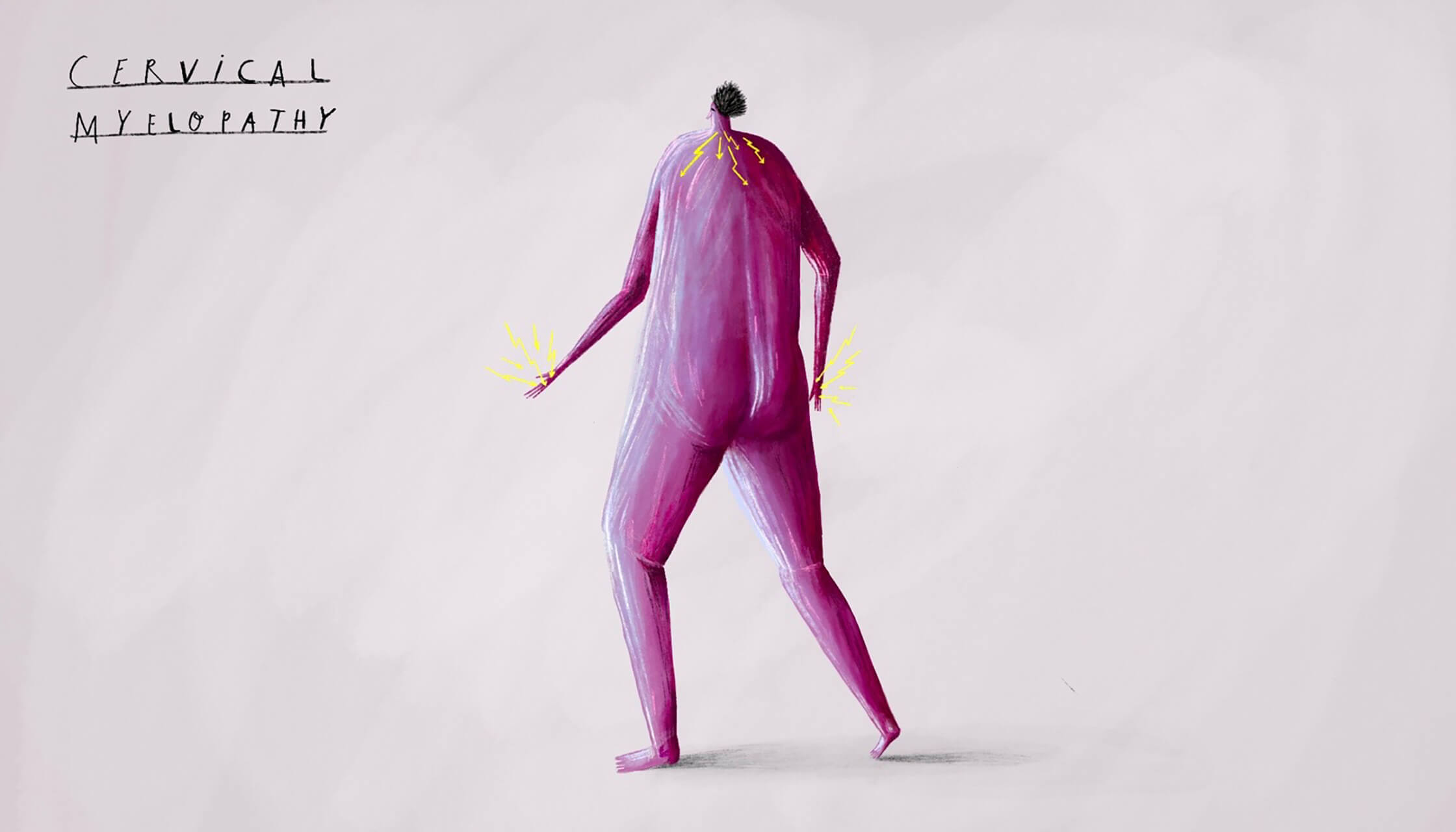Cervical myelopathy
or injury to the spinal cord caused by wear and tear changes in the cervical spine

Neurosurgeon Brisbane
Cervical myelopathy key points
- It is a serious condition that describes the set of symptoms that a patient gets when the spinal cord is gradually compressed by wear and tear changes in the cervical spine (the neck).
- Early on patients notice numbness and clumsiness in their hands and a feeling of unsteadiness in their legs.
- At some point, all the muscles in the arms and legs start to get really stiff and rigid.
- This is a serious condition because the spinal cord can’t repair itself and the symptoms may become permanent.
- Surgery aims to prevent further damage to the spinal cord by immediately taking the pressure off the spinal cord.
- Surgery is the only effective treatment.
Cervical myelopathy Brisbane
What is myelopathy of the cervical spine and is it serious?
Cervical myelopathy describes the set of symptoms that occur when the spinal cord is gradually compressed by arthritis in the cervical spine.
Arthritis can be compared to a callus on your hand: with force and friction, they tend to thicken up.

Spinal surgeon Brisbane
As a result of this compression many of the electrical signals normally travelling through the spinal cord get blocked, similar to an accident causing a bad traffic jam on a busy highway.
Early on patients notice numbness and clumsiness in their hands, and a feeling of unsteadiness in their legs (all due to the traffic jam).
As it progresses, these sensations worsen, and at some point, all the muscles in the arms and legs start to get really stiff and rigid (a sign of a severe traffic jam). This is very serious because there is a chance your symptoms become permanent.
While the condition is serious, the origins of the word myelopathy are quite interesting. Anything to do with the spinal cord is termed ‘myelo’. But myelo also means bone marrow (like myeloma-cancer of the bone marrow). The reason the early anatomists also called the spinal cord ‘myelo’ is because it actually looks very much like bone marrow. Not the red marrow you see in the ends of bones, but the white fatty marrow you see in the middle of long bones. Having seen inside a long bone being chewed by my pet Dachshund, and having also seen inside the spinal cord, I can confirm they look nearly identical!
‘Pathy’ means pathology, or problem. So myelopathy means pathology or problem of the spinal cord.

Spinal surgeon Brisbane
Cervical myelopathy symptoms
What are the symptoms?
Early on patients notice numbness and clumsiness in their hands and a feeling of unsteadiness in their legs. As it progresses, these sensations worsen, and at some point, all the muscles in the arms and legs start to get really stiff and rigid (a sign of a severe traffic jam in the spinal cord due to the compression).
The patient notices their hands are not only numb and uncoordinated but really stiff. And they walk with really stiff legs, which makes the unsteadiness even worse.
Surgeons can recognise the walk of someone with cervical myelopathy very quickly. We call it a scissor gait because the patient’s legs are so stiff they can’t really bend the knee or hips like a normal person, so their legs look like the blades of a pair of scissors opening and closing.
Is it common, do other people get it?
It’s not common. Radiculopathy is much more common (sciatica, femoratica, brachialgia). But when it occurs it must be recognised early and treated early to avoid permanent damage and loss of spinal cord function.
Yes. It usually requires treatment within 1-2 weeks of being diagnosed, and earlier if possible.
Well, there is a very good chance that your current neurological symptoms are permanent, including the clumsy hands and unsteady feet. If you wait, you will just end up losing more function unnecessarily.
Cervical myelopathy causes
What causes it? Did I do something to cause it?
By far the most common cause is wear and tear, also called arthritic changes.
Arthritis can be compared to a callus on your hand, which with force and friction on your hand, tends to thicken up. Likewise, with the force of gravity and spinal movement over years, the bones, disc and ligament tissues tend to thicken up. It is this excess tissue that encroaches on and eventually compresses the spinal cord.
It is not genetic. Everybody gets some degree of arthritis as they get older. It’s just that some get it more than others for some reason. You may be lucky and have a great genetic bloodline whereby your spine responds very well to gravity and movement over the years without much wear and tear, but there is no actual medical genetic condition that causes you to get cervical myelopathy.
Cervical myelopathy treatment in Brisbane
How is it treated?
There is only one treatment for cervical myelopathy, and that is surgery. It is pure mechanics: the spinal cord is physically compressed and the only way to treat this is to physically remove the compression. There is no medication, injection or physiotherapy that will treat this.

Spinal surgeon Brisbane
Cervical myelopathy surgery in Brisbane
Types of surgery?
The two most common operations to treat cervical myelopathy are:
- ACDF: Anterior Cervical Discectomy and Fusion is one of the most common spinal operations performed in Australia. ACDF takes away the front of the spinal canal to create more space for the spinal cord.
- Cervical laminectomy takes away the back of the spinal canal to create more space for the injured spinal cord.
It is not advisable to have an artificial disc inserted for this condition.
Yes, you do. If the diagnosis has been confirmed by your surgeon with a series of questions, scans, and an examination then surgery should be performed as soon as possible. If you have or think you or a family member has this, then contact my team.
Surgery does not aim to make your symptoms better. It only aims to stop you from getting worse. The reason for this is surgery only takes the pressure off the spinal cord, but surgery cannot repair the damage to the spinal cord. If the spinal cord is going to recover to some degree (and often it does not) then it will have to do this on its own using the power of biology and time.
Surgery aims to prevent further damage to the spinal cord by taking the pressure off the spinal cord. Surgery cannot repair the damage to the spinal cord. Occasionally some patients notice an improvement after surgery, but this is the exception rather than the rule.
There are none. Cervical myelopathy is not a condition that can be treated with physiotherapy or by visiting a chiropractor or any other means. In fact, these will actually make you worse and could paralyse you. Surgery is the only effective treatment. Anything else will only cause further damage to your spinal cord and further increase your chances of ending up in a wheelchair. Other than cancer, infection or fractures, this is the single most serious condition in the spine.
It takes about 2 weeks to start feeling a bit more normal again after surgery. During this time I will encourage you to remain active, but you won’t start to get your overall confidence back till about the 2-week mark.
The surgery has about a 5% risk of some complications. However, without the surgery, there is a 100% chance that you will continue to get worse and end up in a wheelchair.
Anyone who recommended this strategy for cervical myelopathy would be considered negligent by all experts around the world.
I will assess you and all your scans to give recommendations on what might be useful in the future to reduce the chances of something similar ever happening again.
It is important to note that the surgery is not designed to make you better, it is designed to stop you from becoming worse. If you get any improvement post-surgery then that is considered a bonus. This all depends on how severe and how long your spinal cord has been compressed. It also depends on an experienced spine surgeon expertly removing all the arthritic tissue completely off the spinal cord.
Cervical myelopathy spinal surgeon in Brisbane
What should I do now?
Please call my team to arrange an urgent review for yourself or a family member you are concerned about.
Ready to make an appointment?
Ramsay Specialist Centre
Suite 325
Newdegate St
Greenslopes QLD 4120

